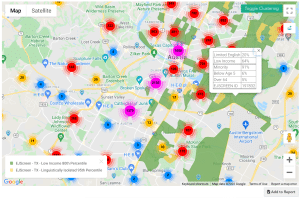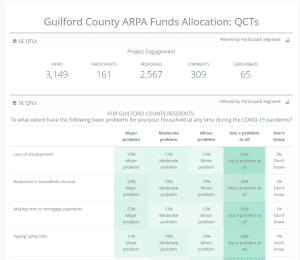
As the National Association of Regional Partnerships, or NARC, wraps up its annual National Conference of Regions meeting in Washington, D.C., two important federal funding initiatives have regions thinking about new opportunities and challenges for their connected jurisdictions.
The American Rescue Plan Act, or ARPA, and the (“Bi-partisan”) Infrastructure Investment and Jobs Act, or IIJA, will distribute $1.9 trillion and $1.2 trillion, respectively, to state and local governments.
National Investment: Local Impacts
ARPA funds are tied to the economic hardships suffered due to the COVID-19 pandemic and can be used for supporting public health expenditures; addressing negative economic impacts of the pandemic; replacing lost public-sector revenue; and providing premium pay for essential workers.
IIJA funds provide a huge multi-year investment into the improvement and innovation of the nation’s infrastructure. Everything from transportation to broadband internet expansion and water pipe replacement are the targets of this federal funding program. Roads and bridges are the biggest beneficiaries.
Social, environmental and infrastructure challenges facing local jurisdictions typically do not stop at a legal boundary. Hence, the need for these jurisdictions to have established formal agreements in place to tackle these challenges and opportunities as a collective.
It’s very common for these agreements to cross state boundaries. For this reason, regional planning, which includes multiple jurisdictions working together to benefit the whole, will be front and center in these programs. Front and center in that process are MPO’s (Metropolitan Planning Organizations) and COG’s (Councils of Governments) as groups focused on regional initiatives and investments.
As the federal government plans a historical disbursement of funds for state and local infrastructure improvements, local governments are preparing to make their pitch for needed funding for their communities. Many of these initiatives will involve multiple jurisdictions and regional planning partnerships will be critical to pursuing federal funding.
Competition, Planning, & Public Engagement
Competition for IIJA funds will be stiff. “This is why it’s crucial that so many state and local government leaders are doing preparatory work now to position their organizations for the coming influx of federal money,” according to Ellory Monks, co-founder of The Atlas, an online community for local government leaders to crowdsource ideas and advice.
Engagement highlighted as a key to securing funding
The focus for local jurisdictions in their planning puts public participation as a top priority. Governments will conduct historical civic listening sessions to collect input from residents about their preferences for infrastructure improvements. How well these jurisdictions capture the collective voices of their residents will be tied to the success and the level of funding requested and received.
IIJA includes descriptive requirements for public engagement
No other federal funding program has been as insistent of jurisdictions and descriptive in their requirements surrounding resident engagement to ensure representation, inclusion, and equity in their public participation efforts.
For example, the IIJA offers provisions promoting digital equity along with a $2.75 billion allocation to the category. Among requirements for jurisdictions to qualify for these funds, they must provide detailed plans that:
-
- Identify barriers to digital equity faced by covered populations in the state;
- Provide an assessment of how the objectives will impact the state’s civic and social engagement; and
- Provide a description of how states plan to collaborate with key community stakeholders and residents
For jurisdictions to meet the important community engagement requirements, the act allows and encourages the use of technology to encourage public participation in the planning process. This encourages public institutions to utilize their civic infrastructure to improve their physical infrastructure.
The Competitive Edge: An Engagement Platform built for equity
Today, many jurisdictions are recognizing the opportunity presented by the pandemic to re-imagine the way they connect and engage with their residents.
PublicInput’s unified public engagement platform helped many jurisdictions provide equitable access to the public process when traditional means of engagement were no longer possible. By providing options for residents to provide input online, by phone, email and even text messaging, organizations reported significant increases in participation.
Increasing the volume of participation is one thing, but measuring improvements in equity has been an even more noteworthy benefit of new approaches. Agencies using PublicInput’s Equity Mapping tool have combined census data layers from the EPA’s EJSCREEN with their resident database to visualize engagement from neighborhoods most impacted by the pandemic.

Equity Mapping layers showing participation in low income and linguistically isolated communities in Austin,TX
Geospatial layers like these can be even more valuable when combined with a resident database that can generate resident segments by census block, EPA EJSCREEN percentile, or other relevant filter such as Qualified Census Tracts (QCT’s). An example below shows how Guilford County, NC did exactly that using PublicInput’s segmentation and reporting tools. By creating a segment of respondents who live or work in Qualified Census Tracts, they were able to zero in on the input from areas that qualify for ARPA spending.

Guilford County leveraged PublicInput’s segmentation tools to report on ARPA engagement specifically from residents in Qualified Census Tracts
QCT’s have historically been a key focus for Community Development Block Grants, but more recently have become relevant in deploying ARPA funding. Federal guidelines offer even greater flexibility for expenditures in Qualified Census Tracts, as these areas are often home to communities, households and businesses disproportionately impacted by the pandemic. With the right technology, agencies can now improve how they engage these communities, and use data to clearly identify key themes and needs.
Whether you’re deploying ARPA funds or pursuing IIJA funding for critical projects, being able to demonstrate equitable community engagement will likely become the tipping point for local governments securing competitive federal dollars for their community.
Want to know more about how your community can achieve a competitive advantage?
Get a virtual demo of equity mapping and equitable engagement tools here:



